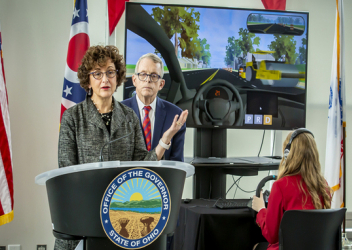Research In Action
Research In Action
Breadcrumb

This week we had a new paper published in a special children's health issue of the journal Health Affairs that describes our unique health-transportation partnership with Ohio and Diagnostic Driving Inc., where we successfully implemented the virtual driving assessment (VDA) in busy licensing test centers without disruption. The paper provides new information that the pilot sample was representative of all people who go for license testing in Ohio (e.g, age and sex distribution).
(Read a previous blog post about the VDA implementation and pilot results.)
Additionally, this paper goes beyond the implementation and pilot study results to discuss the broader policy implications of using the VDA in the field -- in both licensing test centers and now also driving schools in Ohio. This partnership creates opportunities to:
- not only identify underprepared license applicants likely to fail the on-road exam, but also identify drivers more likely to crash immediately post-licensure (focus of future analysis);
- improve driver training by providing automated and personalized feedback to novice drivers on their safety skills that are needed to avoid crashes via their interaction at licensing centers and driving schools
Pandemic Spotlights Utility of Virtual Assessment
The current pandemic has created new challenges for driver testing for licensure: COVID-19 resulted in a number of state and local government functions coming to a halt, including driver license road testing. So in the past few months we have come to realize the added value and need for safely-administered assessments of driving skills prior to licensure.
Unfortunately, unbeknownst to many families, states adopted a variety of strategies that simplified the road test - resulting in less opportunities for examiners to be able to assess the driving skills needed for safety. Known as the Modified Driving Exam, it often involves observing (sometimes from a distance) the applicant perform driving operations like parallel parking in a parking lot.
This concerns us because we know from our research that most families equate passing the road test as having the skills to drive safely. The only gate between supervised driving as a learner and independent driving is the licensing exam, and now our new drivers might be facing independent driving with even less adequate skills than in the past.
While this could have been an ideal use case for the VDA because the workflow is completely self-guided, the enormous backlog created from cancelation of testing appointments made it difficult for administrators to adopt something new.
We have heard that now that the backlog is over, there is renewed interest in considering the use of virtual driving assessment to complement the road test, including as part of 3rd party testing by driving schools. The challenges of 2020 have revealed that there is a critical need to be able to safely assess new drivers beyond the traditional classroom and time behind-the-wheel.
Regardless of the current COVID-19-related health concerns, the future of driver training and licensing is on a path to sustained change and the VDA could play an important role as a reliable and objective assessment. We hope that with Ohio as a model, the precedent has now been set and that states will see that change is not only possible but very feasible.
Flaura K. Winston and I were interviewed by Health Affairs Editor-in-Chief Alan Weil for A Health Podyssey podcast. We encourage you to listen to gain a deeper understanding of the research and policy implications. Click here to listen in.



